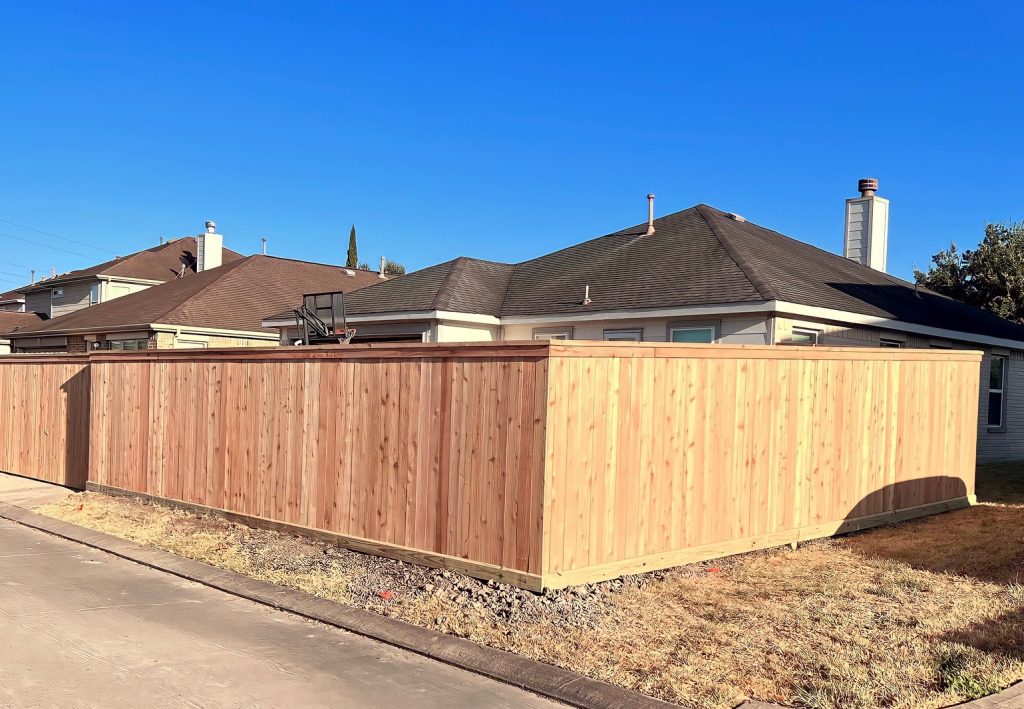New Fence Installation: Texas Fence is The Best
When we’re considering a new fence installation, there’s more to it than simply picking out a design and hammering in some posts. We’ve got to approach this project strategically to make sure we’re not just creating a boundary, but adding value to our property. From choosing the right materials to handling local regulations, each step requires careful thought. Let’s explore the key factors that’ll make our fence installation a success. After all, a well-planned fence can do more than just define our space—it can transform our outdoor living area and enhance our home’s curb appeal. But where should we begin?

Key Points
- Conduct a property survey and mark utility lines before starting fence installation.
- Choose appropriate fencing materials based on durability, maintenance, and local regulations.
- Obtain necessary permits and licenses to comply with local construction laws.
- Prepare the installation area by clearing debris and ensuring flat terrain.
- Invest in quality materials and professional installation to enhance property value and longevity.
Choosing the Right Fence Material
When selecting the appropriate fence material, four primary options stand out: wood, vinyl, aluminum, and chain link. Each of these fence materials offers unique benefits tailored to different needs and preferences.
Our wood fences are designed to meet Miami wind code specifications, ensuring exceptional durability and strength.
For those seeking a low-maintenance option, our vinyl fences come with a transferable lifetime warranty, providing long-lasting peace of mind. Vinyl fencing also resists moisture, insects, and environmental factors, requiring minimal upkeep.
If you’re looking for a blend of style and longevity, our 100% USA-made aluminum fences offer customization options and a lifetime warranty.
We understand that factors like proper maintenance and professional installation have a significant impact on fence longevity. That’s why we prioritize these aspects across all our fence materials. Whether you prefer the classic look of wood, the sleek appearance of vinyl, or the modern appeal of aluminum, we’re here to assist you.
New Fence Installation Preparations
Before we begin our new fence installation, we’ll need to conduct a property survey to confirm our boundaries. We’ll also contact our local utility companies to mark underground lines, making sure we don’t accidentally damage any utilities during installation. These steps are essential for avoiding disputes with neighbors and preventing costly accidents or service disruptions.
Additionally, we utilize high-quality components such as hot-dipped galvanized nails and treated cedar to guarantee durability and longevity. With these steps and materials, we prioritize not only the functionality but also the visual appeal of your new fence.
Property Survey Importance
A property survey serves as the cornerstone of any successful fence installation project. We can’t stress enough how essential it’s to determine our property lines accurately before we begin. By engaging a licensed surveyor, we’ll obtain an official blueprint that’ll guide our fencing project from start to finish.
The precise measurements from a property survey are invaluable when planning our fence layout and design. We’ll have a clear understanding of where our boundaries lie, ensuring we make the most of our available space. When we share this survey with our fencing contractor, we’re guaranteeing that our new fence aligns perfectly with our property boundaries.
One of the most significant benefits of a property survey is its ability to prevent disputes with neighbors. We’re all part of a community, and maintaining good relationships is essential. By having accurate measurements and documentation, we’re protecting ourselves and our neighbors from potential conflicts down the line.
Let’s make sure our fence is installed in the correct location from the get-go. A property survey is our best tool for achieving this, setting the foundation for a smooth and successful fence installation process.
Utility Line Marking
With our property survey in hand, we’re ready to move forward with our fence installation preparations. Our next essential step is utility line marking. We need to contact our local utility companies to mark any underground lines before we begin digging. This precaution is important for our safety and to avoid costly damages.
Once we’ve confirmed the locations of underground utilities, we’ll focus on fence line clearing. We’ll remove any debris, plants, or obstacles along our planned fence path. This step ensures a smooth installation process and helps us prepare the installation area properly.
For wooden fences, we’ll guarantee flat terrain for cutting, while for iron or aluminum fences, we’ll remove any thorny bushes.
As part of our pre-installation preparation, we’ll also remove personal items from the installation area to prevent damage or obstruction during the process. Additionally, we must obtain necessary permits and double-check our property boundaries. These steps are important to guarantee we’re in compliance with local regulations and respecting our neighbors’ property lines.
Obtaining Necessary Permits
When planning your new fence installation in Houston, acquiring the needed licenses is a vital step. We need to be aware that the City of Houston mandates licenses for all construction work, including fence installation. Let’s review the specific requirements to make sure we’re in compliance.
It’s also important to compare methods and styles of different companies to guarantee you’re selecting the right contractor for your needs. For our fellow homeowners, it’s essential to understand that licenses are required for fences over 8 feet tall or those near swimming pools. We’re responsible for securing these licenses before commencing the installation process.
The license fees vary based on the fence height and linear feet, so we’ll need to factor this into our budget. By obtaining the necessary licenses, we’re safeguarding ourselves from potential fines and project delays. It’s our collective responsibility to follow these regulations, ensuring our community maintains its standards and safety measures.
Let’s work together to navigate the permitting process successfully.
Fence Layout and Measurements
Accuracy in fence layout and measurements forms the foundation of a successful installation project. We can’t emphasize enough how vital precise property measurements are for determining the materials needed for your fence installation. To make sure we’re working within the correct boundaries, we recommend conducting a property survey. This step helps identify property lines and prevents potential disputes with neighbors.
For the most reliable results, we suggest engaging a licensed surveyor. They’ll provide an official blueprint for your fence layout, guaranteeing compliance with local regulations. Once you have this blueprint, share it with your fencing contractor. It’ll help us plan the installation process effectively, saving time and resources.
New Fence Installation Process and Timeline
Once the layout and measurements are finalized, we move on to the actual installation process. Our crew begins by setting up equipment and tools with precision, ensuring we’re ready for a smooth and efficient installation. We take pride in our industry-leading 98.5% on-time installation rate, which means you can count on us to complete your project as scheduled.
The installation timeline typically follows a well-defined sequence. We start by securely setting up posts and framework, which serve as the backbone of your new fence.
Next, we meticulously attach fence panels or pickets, paying close attention to even spacing and level placement for a professional result. Gates are installed with their hardware, ensuring proper functionality.
Throughout the process, we maintain a focus on precision and accuracy, as these elements are essential for a durable fence that will stand the test of time.
Once all components are in place, we apply the final touches and conduct a thorough inspection. This step allows us to verify that every aspect of your new fence installation meets our high standards, guaranteeing a sturdy and attractive addition to your property.
Post-Installation Care and Maintenance
Let’s explore essential post-installation care for your new fence installation.
We’ll cover routine cleaning procedures to keep your fence looking its best, including the use of mild soap and water for periodic washing.
We’ll also discuss weatherproofing and protection methods, such as applying sealants or paint to wooden fences, to guarantee your fence’s longevity and resilience against the elements.
Routine Cleaning Procedures
Maintaining your newly installed fence is vital for its longevity and appearance. We recommend implementing a routine cleaning procedure to keep your fence in top condition. Start by regularly cleaning the fence with a mixture of mild soap and water, which effectively removes dirt and grime without damaging the material.
When cleaning, use a soft brush or cloth to gently scrub the fence surface. Avoid harsh chemicals that could potentially harm the fence material. After scrubbing, thoroughly rinse the fence to remove any soap residue, preventing buildup over time.
During these cleaning sessions, it’s essential to inspect your fence for any signs of damage or wear. This proactive approach allows us to address issues promptly, minimizing the need for costly repairs in the future.
Weatherproofing and Protection
After installation, weatherproofing and protection are necessary steps to guarantee your new fence withstands the elements. We must prioritize these post-installation care procedures to enhance our privacy fence’s longevity and durability.
Applying a weatherproof sealant or stain is important, as it shields wood fences from moisture, UV rays, and pests. This protective layer acts as our first line of defense against potential issues like rotting, warping, and fading.
Regular cleaning and inspections are essential components of our maintenance routine. By staying vigilant, we can identify and address any damage or wear early on, preventing minor issues from escalating into costly repairs.
We should follow manufacturer guidelines and recommended care instructions to ensure our fence remains in best condition for years to come.
Let’s commit to a proactive approach in caring for our new fence. By implementing these weatherproofing and protection measures, we’re not just maintaining a boundary; we’re preserving an investment in our property’s aesthetic and functionality. Together, we can create a lasting, well-maintained privacy fence that serves our community for years to come.
Enhancing Property Value With Fencing
For homeowners looking to boost their property’s value, new fence installation can be a wise investment. Real estate experts suggest that a quality fence installation can increase property value by up to 20%. We’ve found that using durable materials like aluminum or vinyl not only enhances curb appeal but also attracts potential buyers in the real estate market.
When we consider fence installation, we’re not just adding a boundary; we’re creating security and privacy for our homes. These factors make our properties more appealing to prospective homeowners. A well-designed fence contributes significantly to enhancing the landscape, improving the overall aesthetic of our property.
We’ve observed that properties with well-maintained fences tend to sell faster. This is likely due to the immediate visual impact and the perceived value of a new fence. By investing in quality materials and proper installation, we’re ensuring durability and long-term benefits.
Let’s not underestimate the power of a fence in transforming our outdoor spaces and boosting our property’s market value. It’s a practical addition that serves both functional and financial purposes.
Frequently Asked Questions
What Is the Cheapest Fence to Install?
We’d suggest chain link fencing as the most budget-friendly option. We can also consider basic wooden fences as an affordable alternative for our project.
What Time of Year Is Cheapest to Install a Fence?
We’ve found that winter and early spring are typically the cheapest times for new fence installation. During these off-seasons, we’ll often see reduced demand, lower labor costs, and potential discounts from fencing companies hungry for business.
Takeaway
We’ve covered the key steps for a successful new fence installation. From selecting materials to post-installation care, we’ve outlined a detailed process. By following local regulations, preparing the site properly, and choosing durable materials, we’ll guarantee a long-lasting fence that enhances our property’s value. Remember, it’s vital to start with a property survey and utility marking. With careful planning and execution, we’ll create a functional and appealing fence that serves our needs for years to come.








